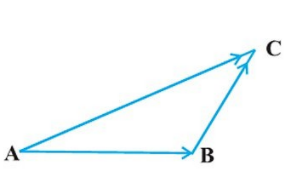Orthocenter of an equilateral triangle ABC is the origin O. If −−→OA=→a,−−→OB=→b,−−→OC=→c, then −−→AB+2−−→BC+3−−→CA=
3→c
3→a
→0
3→b
The correct Answer is:B
To solve the problem, we need to find the value of the expression →AB+2→BC+3→CA given that the orthocenter of triangle ABC is the origin O and the vectors from the origin to the vertices are defined as →OA=→a, →OB=→b, and →OC=→c.
1. Express the vectors in terms of →a,→b,→c:
- The vector →AB can be expressed as:
→AB=→OB−→OA=→b−→a
2. Calculate →BC:
- The vector →BC can be expressed as:
→BC=→OC−→OB=→c−→b
3. Calculate →CA:
- The vector →CA can be expressed as:
→CA=→OA−→OC=→a−→c
4. Substitute these expressions into the original equation:
- Now substitute →AB,→BC,→CA into the expression →AB+2→BC+3→CA:
→AB+2→BC+3→CA=(→b−→a)+2(→c−→b)+3(→a−→c)
5. Distribute and combine like terms:
- Expanding the expression gives:
=→b−→a+2→c−2→b+3→a−3→c
- Combine the terms:
=(−→a+3→a)+(→b−2→b)+(2→c−3→c)
=2→a−→b−→c
6. Use the property of the orthocenter:
- Since O is the orthocenter of triangle ABC, we have:
→a+→b+→c=→0
- Therefore, →c=−(→a+→b).
7. Substituting back into the expression:
- Substitute →c into 2→a−→b−→c:
=2→a−→b−(−→a−→b)
=2→a−→b+→a+→b
=3→a
Final Result:
Thus, the final result is:
→AB+2→BC+3→CA=3→a
- The vector →AB can be expressed as:
→AB=→OB−→OA=→b−→a
- The vector →BC can be expressed as:
→BC=→OC−→OB=→c−→b
- The vector →CA can be expressed as:
→CA=→OA−→OC=→a−→c
- Now substitute →AB,→BC,→CA into the expression →AB+2→BC+3→CA:
→AB+2→BC+3→CA=(→b−→a)+2(→c−→b)+3(→a−→c)
- Expanding the expression gives:
=→b−→a+2→c−2→b+3→a−3→c
- Combine the terms:
=(−→a+3→a)+(→b−2→b)+(2→c−3→c)
=2→a−→b−→c
- Since O is the orthocenter of triangle ABC, we have:
→a+→b+→c=→0
- Therefore, →c=−(→a+→b).
- Substitute →c into 2→a−→b−→c:
=2→a−→b−(−→a−→b)
=2→a−→b+→a+→b
=3→a
Thus, the final result is:
→AB+2→BC+3→CA=3→a
Topper's Solved these Questions
Similar Questions
If ∣∣∣−−→AO+−−→OB∣∣∣=∣∣∣−−→BO+−−→OC∣∣∣ , then A,B,C form
View SolutionAssertion ABCDEF is a regular hexagon and −−→AB=→a,−−→BC=→band−−→CD=→c,then−−→EA is equal to −(→b+→c), Reason: −−→AE=−−→BD=−−→BC+−−→CD (A) Both A and R are true and R is the correct explanation of A (B) Both A and R are true R is not te correct explanation of A (C) A is true but R is false. (D) A is false but R is true.
View SolutionLet O, O' and G be the circumcentre, orthocentre and centroid of a ΔABC and S be any point in the plane of the triangle.
Statement -1: −−−→O'A+−−−→O'B+−−−→O'C=2−−−→O'O
Statement -2: −→SA+−−→SB+−−→SC=3−−→SGView SolutionLet O be the centre of the regular hexagon ABCDEF then find −−→OA+−−→OB+−−→OD+−−→OC+−−→OE+−−→OF
View SolutionIf ABCDEF is a regular hexagon with −−→AB=→a and −−→BC=→b, then −−→CE equals
View SolutionIn a triangle OAC, if B is the mid point of side AC and →OA=→a, →OB=→b, then what is →OC?
View SolutionProve that 3−−→OD+−−→DA+−−→DB+−−→DC is equal to −−→OA+−−→OB+−−→OC.
View SolutionIn triangle ABC (Figure), which of the following is not true:
(A)−−→AB+−−→BC+−−→CA=→0
(B)−−→AB+−−→BC−−−→AC=→0
(C)−−→AB+−−→BC−−−→CA=→0
(D)−−→AB+−−→CB+−−→CA=→0
 View Solution
View SolutionLet O be the centre of a regular pentagon ABCDE and −−→OA=→a, then −−→AB+−−−→2BC+−−−→3CD+−−−→4DE+−−−→5EA is equals:
View SolutionLet O be the centre of a regular pentagon ABCDE and −−→OA=→a, then −−→AB+−−−→2BC+−−−→3CD+−−−→4DE+−−−→5EA is equals:
View Solution

